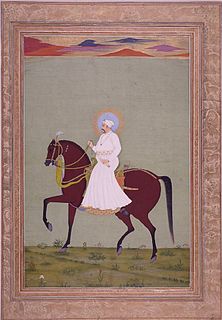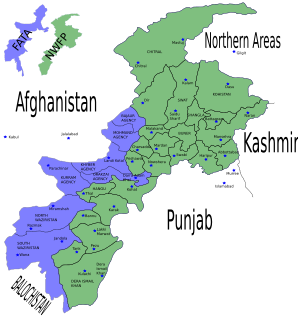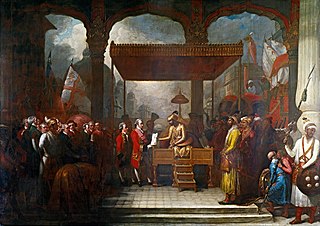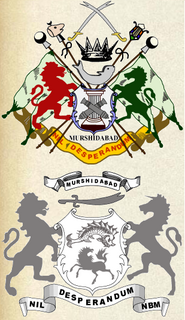
The Durrani Empire, also called the Sadozai Kingdom and the Afghan Empire, was an Iranic empire founded and built by Ahmad Shah Abdali in parts of Central Asia, Middle East and South Asia. At its maximum extent, the empire ruled over the modern-day countries of Afghanistan and Pakistan, as well as parts of northeastern and southeastern Iran, eastern Turkmenistan, and northwestern India.

According to consensus in modern genetics anatomically modern humans first arrived on the Indian subcontinent from Africa between 73,000 and 55,000 years ago. However, the earliest known human remains in South Asia date to 30,000 years ago. Settled life, which involves the transition from foraging to farming and pastoralism, began in South Asia around 7,000 BCE. At the site of Mehrgarh, Balochistan, Pakistan, presence can be documented of the domestication of wheat and barley, rapidly followed by that of goats, sheep, and cattle. By 4,500 BCE, settled life had spread more widely, and began to gradually evolve into the Indus Valley Civilization, an early civilization of the Old world, which was contemporaneous with Ancient Egypt and Mesopotamia. This civilisation flourished between 2,500 BCE and 1900 BCE in what today is Pakistan and north-western India, and was noted for its urban planning, baked brick houses, elaborate drainage, and water supply.

The Maratha Empire or the Maratha Confederacy was a power that dominated a large portion of the Indian subcontinent in the 18th century. The empire formally existed from 1674 with the coronation of Shivaji as the Chhatrapati and ended in 1818 with the defeat of Peshwa Bajirao II at the hands of the British East India Company. The Marathas are credited to a large extent for ending Mughal Rule over most of the Indian subcontinent.

Colonial India was the part of the Indian subcontinent that was under the jurisdiction of European colonial powers during the Age of Discovery. European power was exerted both by conquest and trade, especially in spices. The search for the wealth and prosperity of India led to the colonization of the Americas after their discovery by Christopher Columbus in 1492. Only a few years later, near the end of the 15th century, Portuguese sailor Vasco da Gama became the first European to re-establish direct trade links with India since Roman times by being the first to arrive by circumnavigating Africa. Having arrived in Calicut, which by then was one of the major trading ports of the eastern world, he obtained permission to trade in the city from Saamoothiri Rajah. The next to arrive were the Dutch, with their main base in Ceylon. Their expansion into India was halted, after their defeat in the Battle of Colachel by the Kingdom of Travancore, during the Travancore-Dutch War.

Nasir-ud-Din Muḥammad Shah was the thirteenth Mughal emperor, who reigned from 1719 to 1748. He was son of Khujista Akhtar, the fourth son of Bahadur Shah I. With the help of the Sayyid brothers, he ascended the throne at the young age of 17. He later got rid of them with the help of Asaf Jah I – Syed Hussain Ali Khan was murdered at Fatehpur Sikri in 1720 and Syed Hassan Ali Khan Barha was fatally poisoned in 1722. Muhammad Shah was a great patron of the arts, including musical, cultural and administrative developments. His pen-name was Sadā Rangīla(Ever Joyous) and he is often referred to as "Muhammad Shah Rangila", also sometimes as "Bahadur Shah Rangila" after his grand father Bahadur Shah I.

The North-West Frontier was a region of the British Indian Empire. It remains the western frontier of present-day Pakistan, extending from the Pamir Knot in the north to the Koh-i-Malik Siah in the west, and separating the modern Pakistani frontier regions of North-West Frontier Province, Federally Administered Tribal Areas and Balochistan from neighbouring Afghanistan in the west. The borderline between is officially known as the Durand Line and divides Pashtun inhabitants of these provinces from Pashtuns in eastern Afghanistan.

Alamgir II was the fifteenth Mughal Emperor of India, who reigned from 3 June 1754 to 29 November 1759. He was the son of Jahandar Shah.

The Bombay Presidency, also known as Bombay and Sind from 1843 to 1936 and the Bombay Province, was an administrative subdivision (presidency) of British India headquartered in the city of Bombay. The Summer Capital of the Presidency was Mahabaleswar.

Shah Alam II, born as Ali Gohar or Ali Gauhar, was the seventeenth Mughal Emperor and the son of Alamgir II. Shah Alam II became the emperor of a crumbling Mughal empire.

The Nawab of Bengal was the hereditary ruler of Bengal Subah in Mughal India. The Nawab of a princely state or autonomous province is comparable to the European title of Grand Duke. In the early 18th-century, the Nawab of Bengal was the de facto independent ruler of the three regions of Bengal, Bihar, and Orissa which constitute the modern-day sovereign country of Bangladesh and the Indian states of West Bengal, Bihar and Orissa. They are often referred to as the Nawab of Bengal, Bihar and Orissa. The Nawabs were based in Murshidabad which was centrally located within Bengal, Bihar, and Orissa. Their chief deputy was the Naib Nazim of Dhaka.

The provinces of India, earlier presidencies of British India and still earlier, presidency towns, were the administrative divisions of British governance in India. Collectively, they have been called British India. In one form or another, they existed between 1612 and 1947, conventionally divided into three historical periods:

The Durrani dynasty was founded in 1747 by Ahmad Shah Durrani at Kandahar, Afghanistan. He united the different Pashtun tribes and created the Durrani Empire with his Baloch allies, which at its peak included the modern-day Afghanistan, Pakistan, as well as some parts of northeastern Iran, eastern Turkmenistan, and northwestern India including the Kashmir region. The Durranis were replaced by the Barakzai dynasty during the early half of the 19th century.

The Maratha Conquests were a series of conquests in the Indian subcontinent which led to the building of the Maratha Empire. These conquests were started by Shivaji in 1659 from the victory at the Battle of Pratapgad against Bijapur. The expansion of the empire was limited and interrupted by the Mughal conquests of south India by Emperor Aurangzeb. Marathas were forced to defend their territories against the overwhelmingly strong Mughal army in the 27 years long Deccan wars. They were able to defend their territories and gain an upper hand over Mughals in the sustained conflict.
The 101st Regiment of Foot was an infantry regiment of the Honourable East India Company and British Army that existed from 1652 to 1881. The regiment was raised in India in 1652 by the East India Company as the company's first non-native infantry regiment. Over the following two centuries, the regiment was involved in nearly all of the East India Company's conflicts which consolidated British rule over India. The Royal Bengal Fusiliers was transferred to the command of the British Army in 1862 following the Indian Mutiny of 1857 and the end of Company rule in India. Under the Childers Reforms it amalgamated with the 104th Regiment of Foot to form the Royal Munster Fusiliers in 1881.

The 1st Punjab Regiment was an infantry regiment of the British Indian Army from 1922 to 1947. Upon the Partition of India, it was transferred to the newly-raised Pakistan Army. It ceased to exist in this form in 1956, when it was amalgamated with the 14th, 15th and 16th Punjab regiments to form the Punjab Regiment, an existing infantry regiment of the Pakistan Army.

The military history of the United Kingdom covers the period from the creation of the united Kingdom of Great Britain, with the political union of England and Scotland in 1707, to the present day.

The regiments of Bengal Native Infantry, alongside the regiments of Bengal European Infantry, were the regular infantry components of the East India Company's Bengal Army from the raising of the first Native battalion in 1757 to the passing into law of the Government of India Act 1858. At this latter point control of the East India Company's Bengal Presidency passed to the British Government. The first locally recruited battalion was raised by the East India Company in 1757 and by the start of 1857 there were 74 regiments of Bengal Native Infantry in the Bengal Army. Following the Mutiny the Presidency armies came under the direct control of the United Kingdom Government and there was a widespread reorganisation of the Bengal Army that saw the Bengal Native Infantry regiments reduced to 45.

The presidency armies were the armies of the three presidencies of the East India Company's rule in India, later the forces of the British Crown in India, composed primarily of Indian sepoys. The presidency armies were named after the presidencies: the Bengal Army, the Madras Army and the Bombay Army. Initially, only Europeans served as commissioned or non-commissioned officers. In time, Indian Army units were garrisoned from Peshawar in the north, to Sind in the west, and to Rangoon in the east. The army was engaged in the wars to extend British control in India and beyond.
This Timeline of the British Army 1800–1899 lists the conflicts and wars the British Army were involved in.
This is a timeline of the 18th century.